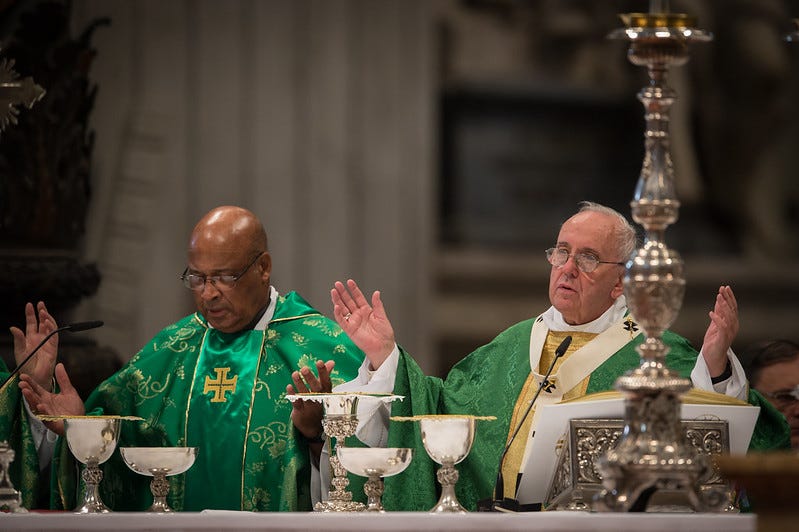The Vatican made a move on Friday that grabbed the attention of liturgists and liturgy nerds around the world.
But if you’re not a liturgist, or a liturgy nerd, you might have seen a few headlines or comments online, and figured it wasn’t really your kind of thing.Perhaps you’re right.
But if you’re liturgy-nerd adjacent, or you offer liturgies, or even if you attend liturgies, it doesn’t hurt to know where the texts come from. And the Vatican’s Friday decree, Postquam summus Pontifex, makes a change to the process of approving liturgical translations.
So what’s changed, and what does it mean? The Pillar explains.
In a nutshell
The new decree, from the Congregation for Divine Worship and the Discipline of the Sacraments, outlines the practical meaning of 2017 reforms to the canon law on liturgical adaptations.
It streamlines the process through which bishops’ conferences can get new liturgical translations okayed by Rome — though it reserves any changes to sacramental formulae to the pope.
It also opens up the process for the possible approval of “radical” adaptations of the liturgy aimed at inculturation, while maintaining a central vetting and approval role for Rome in that process.
How a translation happens
Since the Second Vatican Council, the Church has had a process for the translation of the liturgy of the Roman Rite from Latin, the normative language of the western Church, into the languages spoken around the world.
The work of liturgical translation, as Pope Francis wrote in 2017, “is to announce the word of salvation to the faithful, in obedience to the faith and to express the prayer of the Church to the Lord.”
Before 2017, the process for authorizing new translations was set out in canon 838 of the Code of Canon Law:
The law explains that bishops’ conferences are charged with translating the liturgy, and with updating those translations as needed, primarily through the work of their liturgical and doctrinal committees, and with final vote to adopt them by the whole conference membership.
In cases where a language is spoken in several different countries or regions, like English, the relevant bishops’ conferences often refer to an international group of experts to make recommendations, as is the case with ICEL, the International Commission on English in the Liturgy.
When a bishops’ conference wanted to issue a new translation, it would need the recognitio of the CDW in Rome, a canonical term for a rigorous kind of vetting and approval process in which the congregation examines the translation, and reviews the process used to produce it, offering whatever changes or comments necessary. That process could often take years, and involve lengthy back-and-forth exchanges.
The same process was employed for approving adaptations of the liturgy which add to or are different from the Latin norm, but bishops’ conferences had to work within the limits “defined in the liturgical books themselves” on adaptations.
But in 2017, the pope acknowledged that the process of seeing translations approved — a process mostly between national bishops’ conferences and the Holy See — was sometimes difficult. He said he wanted to create a clearer, smoother, workflow.
What’s changed
In 2017, Pope Francis issued Magnum principium and changed the wording of canon 838, clearing the way for bishops’ conferences to have a little more freedom in working on liturgical translations and proposing “more radical” adaptations of the liturgy.
As with many papal documents, it made specific changes to the text of canon law, and outlined broad themes for how the new text should be interpreted, but with the expectation that more detailed guidance would follow — that guidance came on Friday in a decree from the CDW called Postquam summus Pontifex.
In place of the former requirement for a recognitio from the Vatican, new translations now require the confirmatio of Rome, a different kind of canonical ratification involving less Vatican involvement in the actual translation process.
According to the CDW, the confirmatio is given after Rome is satisfied with “the legitimacy of the approval procedure followed by the Episcopal Conferences” in which the bishops voted to adopt the translation, and checking that biblical quotes and passages in the translated liturgy correspond to the typical Latin version.
It’s a process which, according to CDW guidance issued in 2017 along with Magnum principium, “is therefore not to be considered as an alternative intervention in the process of translation.”
Instead, the confirmatio is “ordinarily granted based on trust and confidence,” and “supposes a positive evaluation of the faithfulness and congruence of the texts produced with respect to the typical Latin text,” the CDW said.
Fr. James Bradley, professor of Canon Law at The Catholic University of America, told The Pillar that Friday’s CDW decree “does a number of things” in clarifying Francis’ 2017 changes to the law, first of all by laying out the new process for approving liturgical translations, but also by “dealing in a number of ways with adaptations to the liturgical books in the Roman Rite” which go beyond mere translation of the Latin original.
“Some of these adaptations are anticipated in the rites themselves and are left to the appropriate episcopal conference to determine,” Bradley said, “and some are these are necessary for the local churches or religious families, such as the proper texts or adaptations to the General Roman Calendar to take account, for instance, of local saints.”
But, Bradley said, other possible adaptations “are more radical in nature.”
Radical adaptations to come?
According to the CDW’s decree, “the more radical adaptation of the Roman Rite, while always safeguarding the substantial unity attested to in the typical liturgical books, is motivated by cultural factors (ritual practices, symbols, gestures) and not by other reasons; in point of fact, this is called the ‘inculturation’ of the Roman Rite.”
Under the terms of Magnum principium’s changes to canon law, and according to the CDW decree, however, the development of any adaptations of the liturgy still need the recognitio of the Vatican.
Unlike the confirmatio used to approve translations, and normally granted on the basis of “trust and confidence, the CDW decrease says that the recognitio involves a much more involved evaluation by Rome, including “the review by the Apostolic See of what has been approved by the Episcopal Conference for its territory, and of the legitimacy of the [way] which has been followed [in its development], taking into account the reasons dictated by the culture, and tradition of a country, and by pastoral needs.”
But, while the Second Vatican Council and Pope Francis both speak about inculturation and the positive possibilities for inculturation of the liturgy, the underlying principle remains unity in the way the Church celebrates Mass and prays together.
“In all of these cases of adaptation,” Bradley said, “the Apostolic See exercises a role of vigilance to ensure that such adaptations are made according to the norm of law, and - where they are more radical in nature - that the proposed adaptations preserve the substantial unity of the Roman Rite.”
Bradley stressed that even where there appear to be radical changes in the liturgy, the intention and effect must actually be to better express the meaning of the original in a particular context.
“In fact,” he said, “the decree itself says that these more radical adaptations are to express ‘through a typology of gestures and symbols, the same content expressed by the traditional gestures and symbols of the Roman Rite.’” Meaning that the changes are themselves meant, in effect, to translate the gestures and symbols of the Roman Rite to be intelligible in a particular cultural context, rather than augmenting the liturgy to accord with local sensibilities.
Bradley explained that, “these adaptations are anticipated by the Second Vatican Council in Sacrosanctum Concilium, and the best known example of this is the so-called Zaire Missal, which incorporates local practices for use in the dioceses of the Congo.”
Approved by the Vatican in 1988, the Zaire missal includes a number of changes to the ordinary form of the Roman Rite, including moving the both the penitential act and the sign of peace to immediately follow the homily. It also includes an invocation of “ancestors of upright heart” in addition to the saints during the liturgy.
“Given that Pope Francis has spoken a number of times about the possibility of adaptations to the Roman Rite for use in the Amazon region, and that the Apostolic See has recently recognized the Ecclesial Conference of the Amazon Region, this may well suggest that further ‘more radical’ adaptations are anticipated,” said Bradley.




